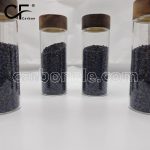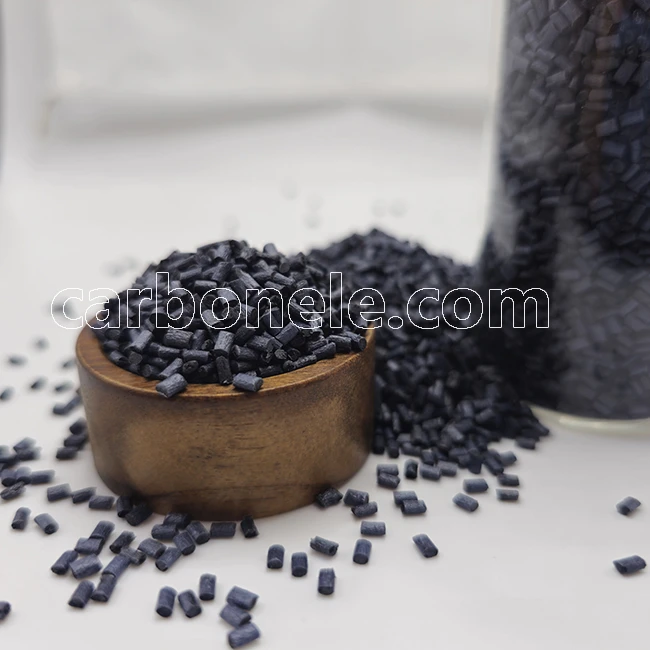
PPS CF25 Plastic Raw Material PPS-CF25
PPS CF 25, having carbon fibers added, not only possesses excellent tensile strength and rigidity to bear relatively large external forces, suitable for components needing high structural strength, but also shows good heat resistance, chemical corrosion resistance, low friction coefficient and dimensional stability, ensuring product quality.
- Manufacturer: Carbon New Material
- OEM/ODM: Acceptable
- Color: Black
- Free Samples: ≤25kgs
- MOQ: 100kgs
- Port: Xiamen
- Model: PPS-CF-BCA2
- Fillers: Carbon fiber
PPS CF25 Plastic Raw Material PPS-CF25
PPS CF25 is a kind of polyphenylene sulfide (PPS) plastic raw material filled with 25% carbon fibers.
I. Composition Content
The main component is polyphenylene sulfide resin, with 25% carbon fibers added. The polyphenylene sulfide endows it with basic thermoplasticity and chemical stability, etc., while the carbon fibers significantly enhance its mechanical properties.
The addition of carbon fibers to PPS resins significantly changes the material’s properties.
Carbon fibers come in two forms: long and short.
Short carbon fibers are usually less than 1 millimeter long. Evenly dispersed, they blend well with the polyphenylene sulfide matrix due to their short length, playing an important role in enhancing mechanical properties, wear resistance, conductivity, and heat resistance. The addition of short carbon fibers makes PPS CF25 perform well in scenarios where there are certain strength requirements for components but not overly strict ones for fiber length. Moreover, its production process is relatively simple and the cost is relatively controllable.
Long carbon fibers range from 1 to 25 millimeters in length. They mainly enhance the structural strength in PPS CF25. Compared to short carbon fibers, long ones show more excellent performance in boosting the tensile strength and impact resistance of the product. When long carbon fibers reach a certain proportion in the material, they can multiply the mechanical strength of PPS CF25 by several or even dozens of times, making it suitable for occasions with extremely high requirements for material strength and stiffness. However, producing long carbon fibers is more difficult, requiring higher production processes and equipment, which leads to a relatively higher cost. In PPS CF25, the rational combination of long and short carbon fibers can fully utilize the advantages of both, giving the material good processing properties and excellent mechanical properties.
| Description | Short Carbon Fibers Filled PPS (PPS CF) | Long Carbon Fibers Filled PPS (PPS LCF) |
|---|---|---|
| Form and Length | Divided into long and short forms. Short carbon fibers are usually less than 1 millimeter in length. | The length ranges from 1 to 25 millimeters. |
| Role in PPS CF25 | Evenly dispersed and blend well with the matrix material. Can improve mechanical properties, wear resistance, electrical conductivity, and heat resistance. Enable PPS CF25 to perform well in scenarios where there are requirements for component strength but not overly strict ones for fiber length. Also, the production process is relatively simple and the cost is relatively controllable. | Mainly serve to enhance the structural strength. Exhibit more excellent performance in enhancing the tensile strength and impact resistance of the product. When reaching a certain proportion in the material, they can significantly improve the mechanical strength of PPS CF25, making it applicable to occasions with extremely high requirements for material strength and stiffness. However, the production is more difficult and the cost is relatively higher. |
| Combined Advantage | – | The rational combination of long and short carbon fibers can enable PPS CF25 to possess both good processing properties and excellent mechanical properties. |
II. Main Performance Characteristics
– High Strength and Rigidity: The addition of carbon fibers enables it to possess excellent tensile strength and rigidity. PPS CF 25 can withstand relatively large external forces and is suitable for components with high requirements for structural strength.
– Good Heat Resistance: It can be used for a long time in a relatively high-temperature environment, with a high heat distortion temperature, and can meet the needs of some high-temperature working conditions.
– Good Chemical Corrosion Resistance: PPS-CF25 has a good tolerance to various chemical substances and performs reliably in scenarios with the risk of chemical corrosion.
– Low Friction Coefficient: Its surface is relatively smooth, with a low friction coefficient, which can reduce the wear and energy loss during the movement of components.
– Good Dimensional Stability: It can maintain relatively good dimensional accuracy under different environmental conditions, ensuring the stability of product quality.
Learn more info about PPS CF25 or other CFRTPs, please click here.
Contact Us
If you want to obtain information such as product specifications, performance, and price, choose a suitable product according to your own needs. Meanwhile, you can ask the manufacturer to provide samples for testing to ensure that the material meets your usage requirements. If you are interested in purchasing this composite material, please contact the manufacturer Carbon (Xiamen) New Material directly.

Frequently Asked Questions
Carbon (Xiamen) New Material Co., Ltd. aims to provide buyers with "one-stop" worry-free high-quality services. Here you can find all information about carbon fiber engineering plastics. If you still have questions, please send us an email for consultation!
-
How can I contact the manufacturer of a product that interests me?
When you find a product you are interested in, you can contact the manufacturer directly by sending an email and we will get back to you as soon as possible.
-
How do I find the products that interest me?
All you need to do is enter the keyword, product name in the search window and press the Enter key on your keyboard. Your search results page will then be displayed. You can also search within the product category pages on the home page. Each category is divided into subcategories, allowing you to refine your search and find products that interest you.
-
Where will I find a buying guide?
Please contact our after-sales service directly and we will provide you with a comprehensive operating guide.
-
What are CF Reinforced Thermoplastic Composites?
CF Reinforced Thermoplastic Composites are materials where carbon fibers are incorporated into a thermoplastic matrix. They combine the strength and stiffness of carbon fibers with the processability and recyclability of thermoplastics. For instance, they are used in automotive parts like bumper beams.
-
What are the benefits of CF Reinforced Thermoplastic Composites over traditional composites?
The key benefits include faster production cycles, easier recyclability, and better impact resistance. They also offer design flexibility. An example is in the manufacturing of consumer electronics casings where complex shapes can be achieved more easily.
-
How are CF Reinforced Thermoplastic Composites processed?
Common processing methods include injection molding, extrusion, and compression molding. Injection molding is widely used for mass production. For example, in the production of small components for the medical industry.
-
What industries use CF Reinforced Thermoplastic Composites?
They are utilized in aerospace, automotive, medical, and sports equipment industries. In aerospace, they can be found in interior components. In the medical field, they might be used in prosthetics.
-
How does the carbon fiber content affect the properties of the composites?
Higher carbon fiber content generally leads to increased strength and stiffness but may reduce ductility. A moderate content is often balanced for specific applications. For example, a higher content might be preferred in structural parts of a race car.
-
What are the challenges in using CF Reinforced Thermoplastic Composites?
Challenges include higher material costs, complex processing equipment requirements, and ensuring uniform fiber dispersion. Issues with adhesion between the fibers and the matrix can also arise. An example is in achieving consistent quality in large-scale production.
























